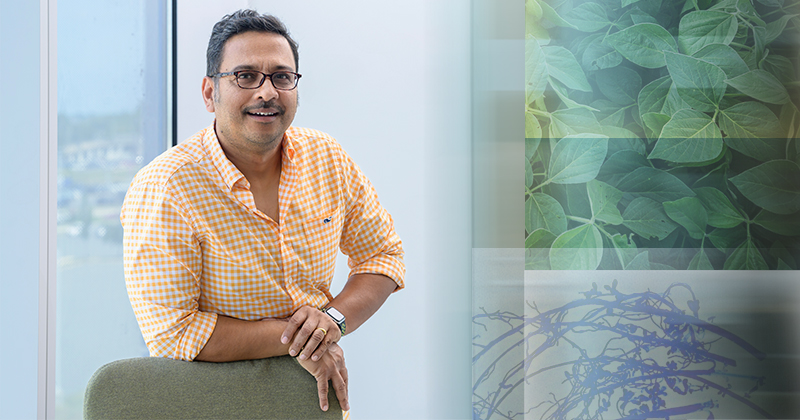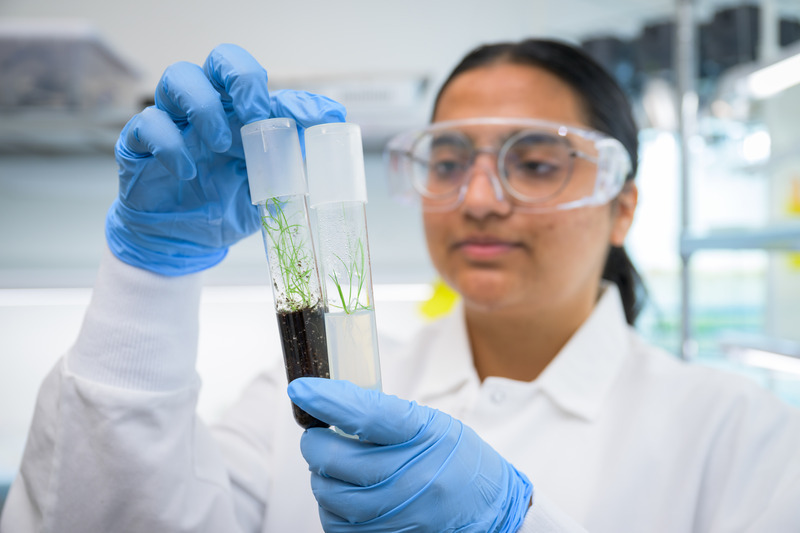

Innovation at UD: Harsh Bais: youtube.com/watch?v=ZMsIF6rPcek
Innovation Ambassador: Harsh Bais
Photos by Kathy F. Atkinson and Evan Krape | Photo illustration by Jeffrey C. Chase | Video by Ally Quinn and Sam Kmiec September 02, 2025
Finding the on-ramp to the innovation highway
Editor’s note: The University of Delaware is diligently working to enhance infrastructure and support available to campus innovators. As part of this effort, the U.S. National Science Foundation's Accelerating Research Translation program (NSF ART program) at UD is investing in capacity-building resources to boost the translation of UD research discoveries into novel technologies of benefit to Delawareans and the nation. UD is an inaugural member of the NSF ART program.
Harsh Bais, professor of plant and soil sciences at the University of Delaware, and a colleague were looking for safe and effective tools to help agricultural growers when they discovered a unique strain of natural, beneficial bacteria, bacillus subtilus, living in the soil and on plant roots. Fundamental research revealed that the microorganism could boost plant defenses against soil-borne diseases, helping plants to flourish.
Bais patented the discovery and, with the help of technology transfer specialists in UD’s Office of Economic Innovation and Partnerships (OEIP), licensed the technology to the global company BASF. Today, the UD-developed beneficial bacterium, known as UD1022, is used across the U.S. and Canada in BASF formulations to protect pea and lentil seedlings, maximizing crop yields.
Since then, that foundational work has led to other patented applications for improving moisture retention in plants, disarming fungal pathogens that affect turf grass, and even improving the ability to grow plants in space.
Earlier this year, Bais was named an Innovation Ambassador at UD, as part of the University’s effort to help other inventors and entrepreneurs find the onramp to the innovation highway. It’s a post that allows Bais to share his experience and support others who are pursuing their own research translation journey. In the following UDaily Q&A, Bais shares a glimpse of what he’s learned about moving discoveries from the lab to the world.

Q: Were you always passionate about translating your research discoveries from lab to market?
Bais: I wasn’t trained to care about intellectual property (IP). I’m a plant biologist, and, as such, our rigor is mainly advising, mentoring and graduating students and helping them publish. That is our prime focus, along with publishing papers, getting grants and teaching. IP is basically something which is not told to you right from the get-go, unless you're an engineering faculty, that comes very natural to them, but not to biologists. But that trend is changing. At UD, we have a very strong intellectual property division in the Office of Economic Innovation and Partnerships (OEIP), and they can really help you understand where the IP lies in your fundamental work.
Q: What role did UD’s Office of Economic Innovation and Partnerships (OEIP) play in UD1022s commercial success?
Bais: In our work related to UD1022 or the follow-up work that came out of it, OEIP really helped us because they were sitting in a place where they could foresee whether an innovation would translate to the market or not. They helped us file a successful patent. They assisted us in finding a commercial partner in BASF, the large chemical company, which was just diving into biologicals ten years back. That helped us a lot with the original UD1022 technology, but also technologies that followed for using UD1022 to increase water retention and drought tolerance, or the historic microbiome work that we are doing right now. In all these cases, OEIP was pivotal in terms of having the foresight that, yes, this is translational, this is novel, this is innovative. And maybe this would be successful in the commercial market.
Q: What is your best advice to scientists interested in commercializing their ideas?
Bais: It's kind of cliche, but I would say think outside the box. Think about who can help you. UD is great at fostering that. Just look at a center like the Ammon Pinizzotto Biopharmaceutical Innovation Center — you have chemical engineers, material scientists, plant biologists, microbiologists all working in one building. In just one day of eating lunch together, you can probably discover ways to cross-pollinate ideas.
Q: What risks and challenges have you encountered along your innovation journey?
Bais: I think the risks and challenges are always related to how you keep your lab going and finding the next funding. Having a viable technology in the field helps your research directions. The availability of innovation driven, in-state funding proposals, such as the Delaware Bioscience Center for Advanced Technology (CAT) grants programs or the State of Delaware Encouraging Development, Growth and Expansion (EDGE) grant competition, can be instrumental in taking your technology to the next level where you can patent it. These in-state programs and other local support can be a huge support for young investigators. It may not be a lot of money, but if you are an innovator, it is important money to take it to the next level. Such programs also can help you connect to Delaware businesses. For example, through a CAT grant, I worked with someone who was making nanoparticles for the paint industry, but we used the technology to encapsulate bacteria and nanoparticles for soil applications. UD’s Horn Entrepreneurship program also is brilliant. Access to this type of local support through the University, OEIP, and the state is what makes UD really a bright place to grow as an innovator.

Q: How have students in your lab benefited from engaging in innovation?
Bais: Any fresh student who comes to lab has the same narrow vision about doing research in a particular field, asking one or two objectives and then trying to answer them in the time they're given. Exposing students to the concept that they may have an innovation sitting under their fundamental question…that excites them. For example, I was talking with a student who works on fortification of proteins and blends, and she was preparing to give a presentation out of state. I mentioned the work to OEIP, then told the student, “Hey, I talked to Christina at OEIP, and she said you might have an innovation there. So how about you hold that thought and show me this data.” This is a simple example of how an awareness of innovation can broaden the student perspective that they can be a coauthor on a patent. Students learning this at a very early stage, say, as a first-year master’s student, is big!
Q: Some of your current work involves growing plants in space. Tell us a bit more about that.
Bais: The biggest problem with leafy greens, mainly your lettuce and spinach, is that they are very prone to contamination by human pathogens. That's why you hear about recalls on these types of food items. Pathogens like salmonella are opportunistic human pathogens that easily enter leafy greens through the plant’s breathing pores, called stomata, even though plants are not their regular host. In collaborative work with food scientist Kali Kniel’s group, our lab showed that using UD1022 we can protect plants by reducing entry by these opportunistic pathogens. As we try to find alternative habitats with the moon mission and the Mars mission, how to grow plants in space under other physical conditions, such as microgravity, becomes a big problem. High carbon dioxide rates also are a factor. So, our idea is to grow plants under microgravity simulation and see how they respond to pathogens like salmonella and listeria. This will expand what is known about plants that can be grown without making our astronauts sick.
Contact Us
Have a UDaily story idea?
Contact us at ocm@udel.edu
Members of the press
Contact us at mediarelations@udel.edu or visit the Media Relations website

